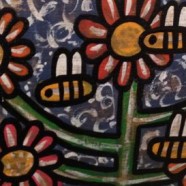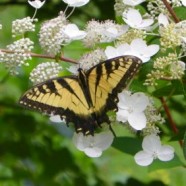A treasure at the farm: the native miner-bee colony
When we were buying this farm one of the owners walked us around to a red clay patch of bare dirt on the east side of the house. It’s an area under an addition that juts out over a steep slope. A series of tiny arched entrances the size of your fingertip covered the slope like an adobe village in miniature. This was the first time I had ever seen a colony of miner bees or chimney bees…
Read MoreSigns of Fall & Missing Cover Crops
Fall is peeking out from behind the green leaves. Long before the oranges and reds take over, colors begin to shift from the velvet and verdant greens to summer to a shinier, more silver hue in the newly angled light. Yellow plumes of golden rod wave along the roadsides, fooling people into believing that is what is making them sneeze this time of year, but it’s not.
Read MoreLove this plant! Panicle Hydrangea
Any plant that attracts this kind of beauty on a daily basis is going to win points with me!
Read MoreBee Bee Tree: Adding this to planting wish list
With a name like Bee Bee Tree, you know it is going to be of interest around here! Like the Chinese Golden Raintree, the Bee Bee Tree fills a late summer niche when there are few other nectar sources for bees and pollinators. For those in the WNC mountains, this bloom chart for beekeepers is handy: http://goo.gl/aMh0a For gardeners interested in bee-friendly plants, here’s a good list : http://goo.gl/56d6s and another one with a tree list included here: http://goo.gl/VRu3f
Will be shopping for a Bee Bee Tree as soon as I have a place to plant one….maybe before if that takes a long while. May have rows of buckets of plants ready for the future homestead long before I have a homestead! Haha. What are some things on your planting wish list? (Comment link is just above the picture.)
Leigh
—A Larrapin Garden…currently in search of a new home in the Blue Ridge of North Carolina. Leigh’s posts on this blog may be boom or bust depending on the season, but if you subscribe here you’ll get one weekly email—usually on Wednesdays—to let you know what’s new. You are also invited to get garden related miscellany and recipes at the brand new Facebook page or on Twitter.
Read MoreNo new plastic, continued. And Water for Wildlife.
As I wrote in the last post, one of my farm lessons this year is to avoid plastic farm buckets, well, except when it’s hard to replace or it’s what you have already... Still, my commitment to metal, wood, stone, pottery and concrete is growing. As the plastic stuff breaks or cracks (set your watch!) I’m transitioning to metal and concrete to hold water. The plastic wildlife dishes—which I already had and will use till they wear out—are changing to the concrete birdbath tops you can find at Lowe’s. (Like the photo below, from a previous post on providing water to wildlife.)
I’d love to make some my own wildlife bowls from concrete too…<nudge to Liz here> I would shape them with the very shallow and sloping sides that the bees love on one old birdbath shown below. They love it because even when the water level goes down, they can still reach it from the safety of dry concrete. A bee can drown in just about anything, but with this design they can climb out to safety, unlike a steep or slick side. It’s so popular we call it the bee-beach and we had to add another bath for the birds the bees displaced from that one! No, the bees do not like birds on their beach and will make that known.
The birds love the rough concrete texture and shallow pool too as it makes for safe footing while bathing. With such a shallow dish, you have to refill often, but that works to eliminate mosquitos since if you ignore it you will have a dry bowl in about 48 hours. Not that you would let it go dry since everything needs water now. The queue to every bird dish we have is several birds deep on many hot afternoons.
Even with deeper wildlife dishes, as long as you dump and refill every 5 days or so, you’ll never raise any mosquitos since they take 7 days to mature… If you are just starting to provide water for wildlife, remember to have containers at ground level as well as traditional birdbaths. There are many critters that can’t drink from an elevated birdbath…like rabbits, turtles, skinks, lizards, etc. (But nix all this info if you have free roaming cats—you don’t want to lure wild creatures to their death.)
Keeping fresh, accessible and safe water sources in many areas around Larrapin has increased the bird and wildlife more than any other single thing we’ve done. How do you provide water for wildlife in your garden?
—A Larrapin Garden www.larrapin.us
Posts most wednesdays & weekends. Don’t miss any—you can subscribe by Email here. You can also get bonus links and recipes by “liking” our Facebook fan page atwww.facebook.com/larrapin.garden. We’re even on Twitter athttp://twitter.com/LarrapinGarden.











